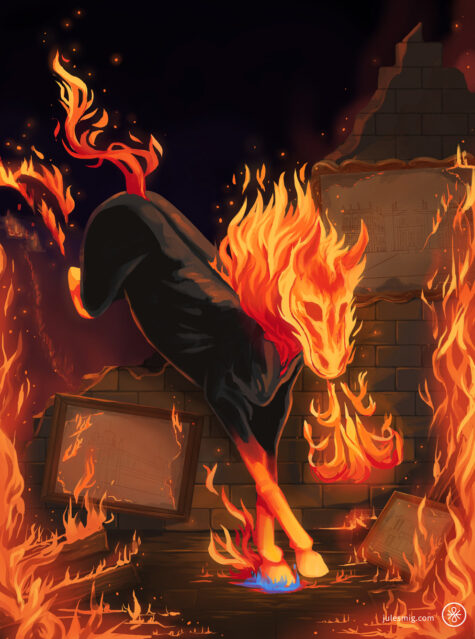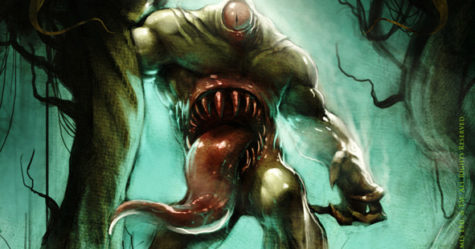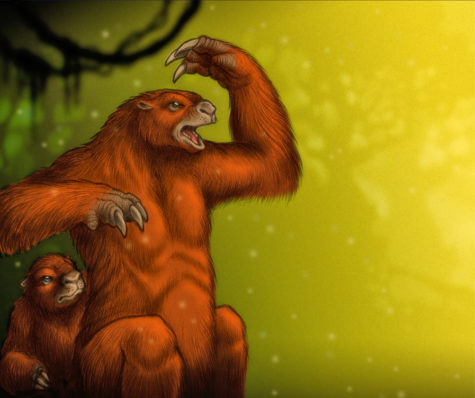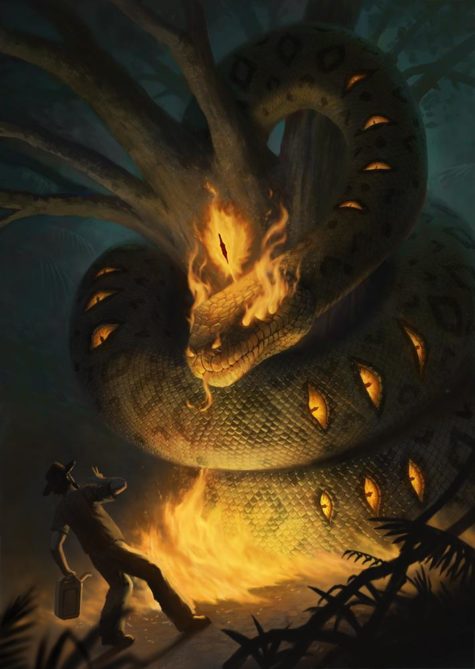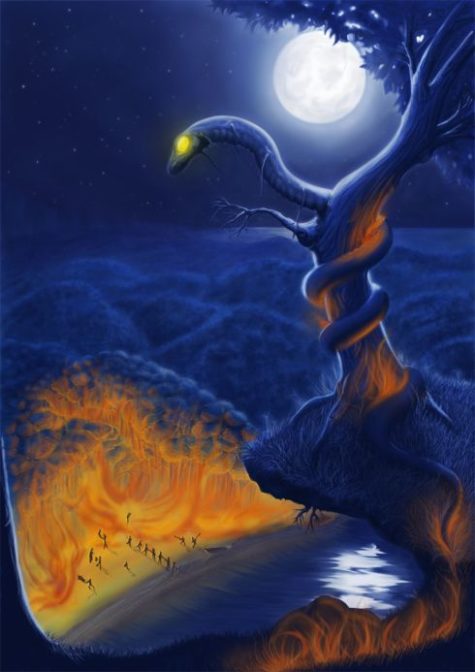Brazil

Brazil has its fair share of urban legends, some of them terrifying. Take the legend of the Loira do Banheiro (the bathroom blonde), for instance. This legend tells the tale of an amazingly beautiful girl with long blonde hair who killed herself (or was killed) in a bathroom.
In some stories, she is a bride ghost who lives inside the last stall of every public bathroom. Her soul is trapped there, and she must spend the rest of eternity scaring the crap out of people who show up to do their business.
There are other blonde woman legends as well, including one that involves a blonde on the street who tricks men into giving her a lift, then tries to murder them.
Popular Versions of the Loira do Banheiro Story:
They say she is the ghost of a dead girl with long blond hair. Her nose and mouth are stuffed with bloody cotton, blood streams from her empty eye sockets and her skin is covered in small cuts. Some say she appears in the mirror and stares at you and others say she asks you to take the cotton out of her nose.
To make her appear, you must go to the last stall in the bathroom and kick the door 3 times, flush the toilet 3 times, turn a tap on and off 3 times and say a curse word out loud 3 times.
According to this legend, she was once a beautiful blonde girl who always skipped classes and hung out in the school bathroom, smoking, drinking alcohol and generally getting up to no good. Then one day, during these escapades, she slipped on the wet bathroom floor and hit her head on a toilet and bled to death.
Not satisfied with her premature and tragic end, her soul would not rest in peace, and since that day, the toilets of schools are haunted by the spirit of the dead blonde.
In another legend, her name was Maria Augusta and she was the daughter of a Brazilian viscount. At the tender age of 14, her parents forced her to marry a man she didn’t love. He was also much older than her and she was very unhappy in the marriage.
She ended up having an affair with another man and she ran away to Europe with her lover. Unfortunately she died of pneumonia and her remains were shipped back to her parents. They say that at the exact moment of her death, a mirror in her parents house shattered. Her parents put her body on display in a glass case and refused to bury her.
There is yet another legend that claims the blonde in the bathroom was once a teacher who fell in love with one of her students. When her husband found out, he flew into a jealous rage and murdered her.
First he stabbed her and sliced her face to ribbons, then he stuffed her head down one of the school toilets until she drowned.
An Eyewitness Account:
It all started when this girl in my class started reading about urban legends on the internet and found the famous legend of the blonde in the bathroom. She told all of us that she was going to do the ritual. She did everything right and she was alone in the bathroom with the door locked. I don’t know what happened while she was alone in there, but when she came out she acted like nothing had happened.
When we asked her if the ritual worked, she was like, “What are you talking about?” She couldn’t remember anything about it. When one of my friends mentioned something about the blonde in the bathroom, the girl suddenly began to bang her head on the table, her eyes turned back in her head and she gave a horrible screech. Her parents had to come and take her home. When she came back to school a few days later, she said, “I don’t know, I do not remember anything!”
Another Eyewitness Account:
When I was little I was always fascinated by the supernatural. One day my friend and I were in school when we heard someone screaming from the second floor. We ran up there and what we saw was incredible.
We saw many people gathered around the door of the bathroom and just as we were going to see what was going on, we saw a student running scared and crying. There was a woman following her with a bloody nose, bloody face, and her skin was all torn and bleeding. Most importantly, she was blonde.
After a while, we saw two nuns coming and the blonde ran into the bathroom. When the nuns opened the door, the bathroom was empty. She disappeared. To this day, I can still remember that face.
Sources:
The Headless Mule or Mula-Sem-Cabeça, is a mythical character in Brazilian folklore. The Mule’s appearance varies greatly from region to region. Its color is most commonly given as brown, sometimes as black. It has silver (or iron) horseshoes that produce a hideous trotting sound, louder than any horse is capable of producing.
The legend of the mula tells of a girl or woman who was cursed for having relations with a priest. As punishment for her part in a man of God’s sin, she is condemned to transform into a wild mule with fire in place of a head, shooting flames from its nonexistent nostrils and stampeding through villages at night. In the morning, she reverts to her human form, waking up naked and unable to remember a thing.
Transformation usually occurs at a crossroads. Depending on the source the headless mule may have a placeholder head and mane, made of the fire it spews, to which a red-hot iron bridle is tied.
Despite being headless, the Mule still neighs (usually very loud), and sometimes it moans like a crying woman. Is said to produce a piercing, terrifying noise during its rampage, and the clattering of its gold or silver shoes strikes fear into all who hear it. If you get too close, it might kick you into the afterlife.
To successfully hide from the mula, you must ensure specific body parts are concealed from its sight, as it seems to enjoy eating eyes, thumbs, teeth, etc., depending on which version of the legend you recall while in the process of dying of fright.
The transformation can be reversed temporarily by spilling the mule’s blood with the prick of a needle or by tying her to a cross. In the first case, transformation will be prevented while the benefactor is alive and lives in the same parish in which his feat was accomplished. In the second case the woman will remain in human form until the sun dawns, but will transform again the next time.
A more stable removal of the curse can be achieved by removing the bridle, in which case the woman will not shape shift again while the benefactor is alive. Tying the bridle back to the woman’s mouth will return the curse.
Removal of the curse is a great relief for the woman because the curse includes many trials, so the grateful woman will usually repent her sins and marry the benefactor. In any case, when the mule changes back to human form the accursed woman will be completely naked, sweated, and smelling of sulfur.
A person who encounters the mule should not cross its path, or the mule will follow the offender and trample him down. Instead, one should either be brave enough to remove the bridle or spill its blood, or else just lay face down on the ground, covering teeth and nails (as well as anything that shines) and the mule will hopefully fail to notice the stranger’s presence and trot away (because it has poor vision).
Some versions of the legend curse the priest instead of the woman, usually following a twist where the aforementioned relations are violently one-sided in the priest’s favor. Some also say the mula is a girl who lost her virginity outside of marriage. A third, more fantastic version involves a queen who had a bad habit of digging up kids’ graves and eating the corpses… until the king caught her in the act, whereupon she transformed into the mula and charged headlong into the night.
Sources:
The mapinguari (“roaring animal” or “fetid beast”) is basically the bigfoot of South America. This roaring beast wanders the forests of South America, tearing down brush and trees with its powerful claws and leaving behind a trail of destruction as it looks for food.
According to native folklore the creature has a series of unnatural characteristics related to other fantastic beings of Brazilian mythology. These include the creature only having one eye, long claws, lizard-like skin, backward feet, and a second mouth on its belly. In more recent alleged eyewitness accounts, it has consistently been described as resembling either an ape or giant ground-dwelling sloth and having long arms, powerful claws that could tear apart small trees, a sloping back, reaching heights of 7 feet when standing on its hind legs, and covered in thick, matted fur.
This cryptid is described as a giant smelly beast that can stand on its feet like a grizzly, having the face of a monkey and thick fur over skin tough enough to stop a shotgun round in its tracks. Some sources have reported it sporting a second mouth in the middle of its belly, which emits a disgusting odor that leaves men dizzy, confused, and unconscious.
According to legend, it is slow but ferocious and very dangerous due to its ability to move without noise in the thick vegetation, surprising the unsuspecting locals. Accounts state that it gave off a putrid stench and emitted a frightening shriek, and that weapons such as arrows and bullets could not penetrate the Mapinguari’s alligator-like hide.
Its only known weakness is that it avoids bodies of water, which limits its movements in a region where so many rivers, brooklets and lagoons exist (especially during the rainy season). It was believed to be carnivorous, as a 1937 report from central Brazil claimed a mapinguari had gone on a three-week rampage, killing over 100 cows and ripping out the tongues from their carcasses. However, in all accounts it did not eat humans, although when it smells the presence of people it stands up on its back feet, becoming as tall as two metres, a movement similar to grizzly bears.
Often, people say the mapinguari serves as a sort of jungle protector, attacking those who take more resources than necessary. In this sense, it is similar to other legendary protector/punisher figures, like the boitatá and the curupira, a creature with backward feet who finds joy in confusing hunters.
According to Brazilian stories, the Mapinguari was once an Amazonian shaman who discovered the key to immortality thousands of years ago. He angered the gods and was severely punished as to his discovery, which forced him to be transformed into a wandering beast for the rest of his life.
Most sightings show the beast as a giant sloth, although a few see it as an ape-like creature. Most cryptozoologists speculate that the Mapinguari is either a Megatherium, a large giant ground sloth from the Ice Age that lived in the area, or another species of Giant Sloth.
There are accounts of this sort of creature that span tribal groups who have no contact with each other, and many similar stories from hunters, rubber tappers, and more. The ubiquity and consistency of these reports piqued the interest of some scientists. One, an ornithologist named Dr. David Oren, has arranged expeditions to search for the mapinguari, but so far has collected zero sightings and a bunch of hair and feces that turned out to be be the deposits of giant anteaters and the hair of small rodents.
One member of the Machiguenga tribe in Peru told another scientist, Dr. Glenn Shepard, that he had seen a mapinguari in a museum in Lima. That museum just so happens to include a display featuring a model of Megatherium.
Lucas Karitiana, a member of the Karitiana tribe in Brazil, insists his son encountered one in the forest, and, although he escaped unscathed, the whole surrounded area looked “as if a boulder had rolled through and knocked down all the trees and vines.”
Sources:
- Alternate Names: Baitatá, Biatatá, Bitatá, Batatão, Batatá, Mboitatá, M’boiguaçu, Mbaê-Tata
- Origins: Brazilian mythology, legend and folklore
- Element: Fire, Water
- Species: Serpent
- Appearance: Flaming, bright, giant horned aquatic serpent, or glowing eyes in the dark
- Powers: Protects the Rainforest
- Manifestation: A giant snake with enormous fiery eyes that crawls over the open fields at night. Sometimes described as a giant fire snake.
Boitatá is a mythological serpent from Brazilian mythology, legend and folklore. It is the Brazilian equivalent of the will-o’-the-wisp. The name comes from the Old Tupi language and means “fiery serpent” (mboî tatá). Its great fiery eyes leave it almost blind by day, but by night, it can see everything.
The Boitatá is a good entity, but it may kill anything which is violating the forests. Their diet consists of eyes from dead animals or its victims.
According to the legend, there was once a long period of darkness when the sun did not shine and a deluge flooded the earth. These conditions killed many animals and forced the beasts to flee their natural habitat. A “boiguaçu” (a cave anaconda) left its cave after the deluge and, in the dark, went through the fields preying on the animals and corpses, eating exclusively its favorite morsel, the eyes of the dead, which shone brightly in the darkness and made for tasty delicacies.
As the snake ate more and more of these delicious, shiny eyes, its body began to shine. The collected light from the eaten eyes gave “Boitatá” its fiery gaze, but the eyes-only diet steadily weakened it, and it perished… in a blaze of glory. For, upon its death, all the light collected inside it escaped to the sun, and the dark days were finally over.
There must have been some magic in all those eyeballs, because the boitatá lived on in spirit. It inhabits the Amazon jungles to this day, often appearing at night as nothing but two glowing, fiery eyes. Some say it can breathe fire as well, an ability it uses to incinerate people who harm the rainforest by chopping trees down or starting fires.
Others say it can actually disguise itself as a tree trunk, then roast alive any lumberjack who comes to cut it down. It is also said that it will blind you and make you insane if you gaze into its eyes.
Variations:
There are other versions of the legend that describe the boitatá as a giant, fiery bull who hunts the hunters, and yet others that associate it with almas penadas – souls that are cursed for various reasons, from immorality to dealing dishonestly with the devil.
Many descriptions of the boitatá legend connect it with ignis fatuus, or that fiery phenomenon known as the will-o’-the-wisp. There is some overlap between the legends of the boitatá and the boiúna, an evil black snake that is said to take a variety of forms, attack and devour people, and use its flaming eyes to lead boats to their ruin.
Sources:





